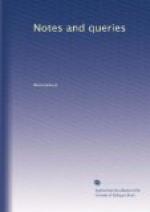J. Sansom.
* * * * *
CAXTON’S PRINTING-OFFICE.
I must protest against the manner in which Arun (Vol. ii., p. 187.) has proceeded with the discussion of Caxton’s printing at Westminster. Though writing anonymously himself, he has not hesitated to charge me by name with a desire to impeach the accuracy of Mr. C. Knight’s Life of Caxton, of which, and of other works of the same series, he then volunteers as the champion, as if they, or any one of them, were the object of a general attack. This is especially unfair, as I made the slightest possible allusion to Mr. Knight’s work, and may confess I have as yet seen no more of it than the passage quoted by ARUN himself. Any such admixture of personal imputations is decidedly to be deprecated, as being likely to militate against the sober investigation of truth which has hitherto characterised the pages of “NOTES AND QUERIES.” ARUN also chooses to say that the only question which is material, is, Who was Caxton’s patron? i.e. who was the Abbot of Westminster at the time,—who may not, after all, have actively interfered in the matter. This question remains in some doubt; but it was not the question with which DR. RIMBAULT commenced the discussion. The object of that gentleman’s inquiry (Vol. ii., p. 99.) was, the particular spot where Caxton’s press was fixed. From a misapprehension of the passage in Stow, a current opinion has obtained that the first English press was erected within the abbey-church, and in the chapel of St. Anne; and Dr. Dibdin conjectured that the chapel of St. Anne stood on the site of Henry VII.’s chapel. The correction of this vulgar error is, I submit, by no means immaterial; especially at a time when a great effort is made to propagate it by the publication of a print, representing “William Caxton examining the first proof sheet from his printing-press in Westminster Abbey;” the engraving of which is to be “of the size of the favourite print of Bolton Abbey:” where the draftsman has deliberately represented the printers at work within the consecrated walls of the church itself! When a less careless reader than Dr. Dibdin consults the passage of Stow, he finds that the chapel of St. Anne stood in the opposite direction from the church to the site of Henry VII.’s chapel, i.e. within the court of the Almonry; and that Caxton’s press was also set up in the Almonry, though not (so far as appears, or is probable) within that chapel. The second question is, When did Caxton first set up his press in this place? And the third, the answer to which depends on the preceding, is, Who was the abbot who gave him admission? Now it is true, as ARUN remarks, that the introduction of Abbot Islip’s name is traced up to Stow in the year 1603: and, as Mr. Knight has observed, “the careful historian of London here committed one error,” because John Islip did not become Abbot of Westminster until 1500. The entire passage of Stow has been quoted by DR. RIMBAULT in “NOTES AND QUERIES,” Vol. ii., p. 99.; it states that in the Almonry—




